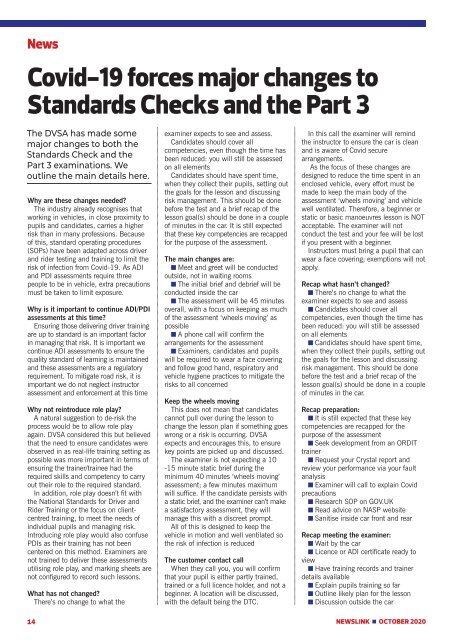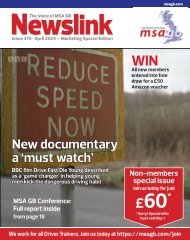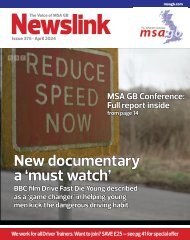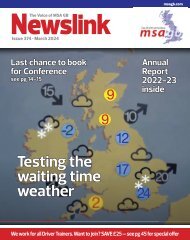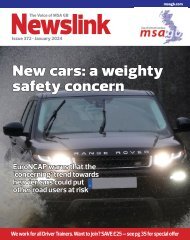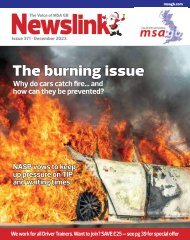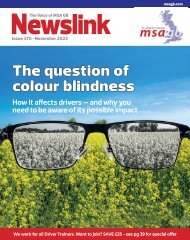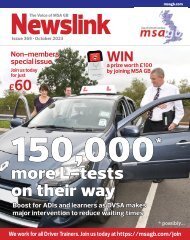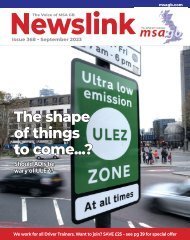Newslink October
Membership magazine of the Motor Schools Association of Great Britain. Covers driver training and testing, road safety and other motoring issues
Membership magazine of the Motor Schools Association of Great Britain. Covers driver training and testing, road safety and other motoring issues
- No tags were found...
Create successful ePaper yourself
Turn your PDF publications into a flip-book with our unique Google optimized e-Paper software.
News<br />
Covid-19 forces major changes to<br />
Standards Checks and the Part 3<br />
The DVSA has made some<br />
major changes to both the<br />
Standards Check and the<br />
Part 3 examinations. We<br />
outline the main details here.<br />
Why are these changes needed?<br />
The industry already recognises that<br />
working in vehicles, in close proximity to<br />
pupils and candidates, carries a higher<br />
risk than in many professions. Because<br />
of this, standard operating procedures<br />
(SOPs) have been adapted across driver<br />
and rider testing and training to limit the<br />
risk of infection from Covid-19. As ADI<br />
and PDI assessments require three<br />
people to be in vehicle, extra precautions<br />
must be taken to limit exposure.<br />
Why is it important to continue ADI/PDI<br />
assessments at this time?<br />
Ensuring those delivering driver training<br />
are up to standard is an important factor<br />
in managing that risk. It is important we<br />
continue ADI assessments to ensure the<br />
quality standard of learning is maintained<br />
and these assessments are a regulatory<br />
requirement. To mitigate road risk, it is<br />
important we do not neglect instructor<br />
assessment and enforcement at this time<br />
Why not reintroduce role play?<br />
A natural suggestion to de-risk the<br />
process would be to allow role play<br />
again. DVSA considered this but believed<br />
that the need to ensure candidates were<br />
observed in as real-life training setting as<br />
possible was more important in terms of<br />
ensuring the trainer/trainee had the<br />
required skills and competency to carry<br />
out their role to the required standard.<br />
In addition, role play doesn’t fit with<br />
the National Standards for Driver and<br />
Rider Training or the focus on clientcentred<br />
training, to meet the needs of<br />
individual pupils and managing risk.<br />
Introducing role play would also confuse<br />
PDIs as their training has not been<br />
centered on this method. Examiners are<br />
not trained to deliver these assessments<br />
utilising role play, and marking sheets are<br />
not configured to record such lessons.<br />
What has not changed?<br />
There’s no change to what the<br />
examiner expects to see and assess.<br />
Candidates should cover all<br />
competencies, even though the time has<br />
been reduced: you will still be assessed<br />
on all elements<br />
Candidates should have spent time,<br />
when they collect their pupils, setting out<br />
the goals for the lesson and discussing<br />
risk management. This should be done<br />
before the test and a brief recap of the<br />
lesson goal(s) should be done in a couple<br />
of minutes in the car. It is still expected<br />
that these key competencies are recapped<br />
for the purpose of the assessment.<br />
The main changes are:<br />
n Meet and greet will be conducted<br />
outside, not in waiting rooms<br />
n The initial brief and debrief will be<br />
conducted inside the car<br />
n The assessment will be 45 minutes<br />
overall, with a focus on keeping as much<br />
of the assessment ‘wheels moving’ as<br />
possible<br />
n A phone call will confirm the<br />
arrangements for the assessment<br />
n Examiners, candidates and pupils<br />
will be required to wear a face covering<br />
and follow good hand, respiratory and<br />
vehicle hygiene practices to mitigate the<br />
risks to all concerned<br />
Keep the wheels moving<br />
This does not mean that candidates<br />
cannot pull over during the lesson to<br />
change the lesson plan if something goes<br />
wrong or a risk is occurring. DVSA<br />
expects and encourages this, to ensure<br />
key points are picked up and discussed.<br />
The examiner is not expecting a 10<br />
-15 minute static brief during the<br />
minimum 40 minutes ‘wheels moving’<br />
assessment; a few minutes maximum<br />
will suffice. If the candidate persists with<br />
a static brief, and the examiner can’t make<br />
a satisfactory assessment, they will<br />
manage this with a discreet prompt.<br />
All of this is designed to keep the<br />
vehicle in motion and well ventilated so<br />
the risk of infection is reduced<br />
The customer contact call<br />
When they call you, you will confirm<br />
that your pupil is either partly trained,<br />
trained or a full licence holder, and not a<br />
beginner. A location will be discussed,<br />
with the default being the DTC.<br />
In this call the examiner will remind<br />
the instructor to ensure the car is clean<br />
and is aware of Covid secure<br />
arrangements.<br />
As the focus of these changes are<br />
designed to reduce the time spent in an<br />
enclosed vehicle, every effort must be<br />
made to keep the main body of the<br />
assessment ‘wheels moving’ and vehicle<br />
well ventilated. Therefore, a beginner or<br />
static or basic manoeuvres lesson is NOT<br />
acceptable. The examiner will not<br />
conduct the test and your fee will be lost<br />
if you present with a beginner.<br />
Instructors must bring a pupil that can<br />
wear a face covering; exemptions will not<br />
apply.<br />
Recap what hasn’t changed?<br />
n There’s no change to what the<br />
examiner expects to see and assess<br />
n Candidates should cover all<br />
competencies, even though the time has<br />
been reduced: you will still be assessed<br />
on all elements<br />
n Candidates should have spent time,<br />
when they collect their pupils, setting out<br />
the goals for the lesson and discussing<br />
risk management. This should be done<br />
before the test and a brief recap of the<br />
lesson goal(s) should be done in a couple<br />
of minutes in the car.<br />
Recap preparation:<br />
n It is still expected that these key<br />
competencies are recapped for the<br />
purpose of the assessment<br />
n Seek development from an ORDIT<br />
trainer<br />
n Request your Crystal report and<br />
review your performance via your fault<br />
analysis<br />
n Examiner will call to explain Covid<br />
precautions<br />
n Research SOP on GOV.UK<br />
n Read advice on NASP website<br />
n Sanitise inside car front and rear<br />
Recap meeting the examiner:<br />
n Wait by the car<br />
n Licence or ADI certificate ready to<br />
view<br />
n Have training records and trainer<br />
details available<br />
n Explain pupils training so far<br />
n Outline likely plan for the lesson<br />
n Discussion outside the car<br />
14<br />
NEWSLINK n OCTOBER 2020


